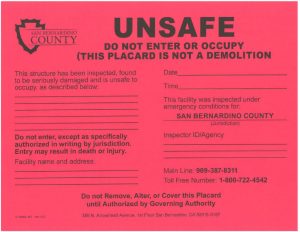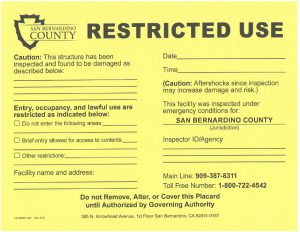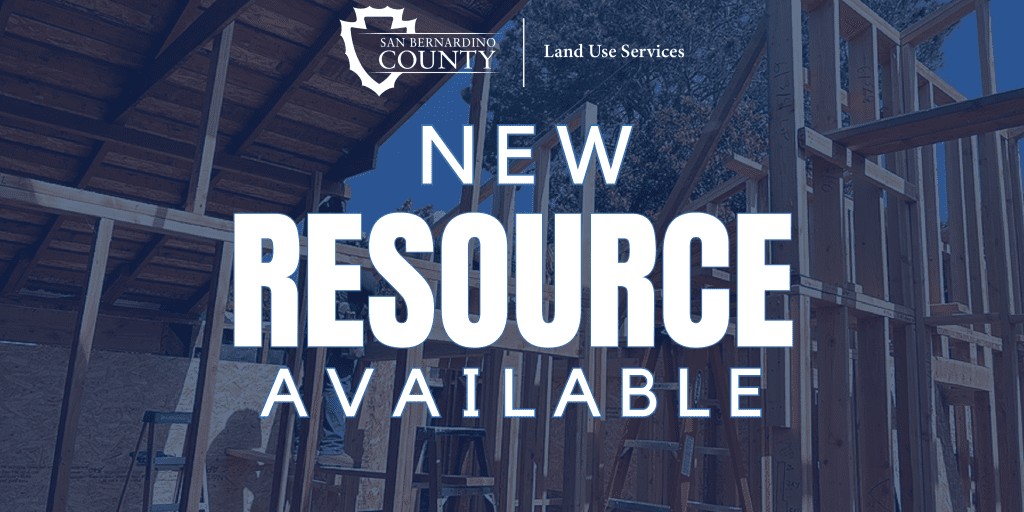ANNOUNCEMENTS:
Have Building and Safety questions? Submit an online form here.
Schedule an online inspection
Need help? Watch this quick video tutorial.
Red Placard (Unsafe Posting)

This placard indicates it is unsafe to occupy or enter the building for any reason. This placard is posted only when there is an immediate risk associated with entry, use or occupancy. This posting does not automatically mean that the property has been condemned or will require demolition. Entry into the structure, for the purpose of repairs, can be made by a licensed contractor or engineer, and a permit will be required to make the necessary repairs.
Yellow Placard (Restricted Use Posting)

This placard indicates that an unsafe condition exists. The Restricted Use placard may be used, as an example, when an inspection reveals damage of a nature that requires that there be no entry to a portion of the building or some restriction on the use or occupancy of the whole building. Overall damage may be such that entry is appropriate for occupants to remove belongings and for contractors to make repairs, but is not appropriate for normal occupancy. A description of the limits of entry or use will be written on the placard. Depending on the type of damage, a permit may be required to correct the deficiencies.
Green Placard (Inspected Posting)

This placard indicates that damage does not pose any significant safety hazard. This posting is intended only to inform occupants that the building may be safety occupied; it does not imply that existing damage should be ignored or that repairs are not necessary. If an inspector was not able to enter the building, but found no hazard at the exterior, the INSPECTED placard will be marked “Exterior Only.” If the inspection team was also able to enter the building and found no hazards, the INSPECTED placard will be marked “Exterior and Interior.” If you return to your building and find an INSPECTED placard marked “Exterior Only,” you should request a reinspection if you believe there are hazards inside the building.
Western Joshua trees (Yucca brevifolia) are now protected by the State of California as a candidate species for listing under the California Endangered Species Act (CESA). At this time, the County cannot issue a permit to take (by removal or transplanting) any Joshua tree.
Effective Immediately: Hard Copy Approved Plans Must Be Kept on Job Site During the Inspection Process
Due to recent concerns related to the clarity and ability to view electronic plans during the inspection process for complex construction
projects, the Building and Safety Division will now require approved building plans to be printed full size (24”x36”) and kept
on the job site at all times during the inspection process. This will provide for greater efficiency in the inspection process.
Building & Safety
Building and Safety’s primary responsibility is the enforcement of Building Standards adopted by the State of California and San Bernardino County. These standards include the California Building, Electrical, Plumbing, Mechanical, and Energy Codes, and Disabled Access Regulations contained in Title 24 of the California Code of Regulations.
The enforcement of these codes is accomplished through the “permit process.” The permit process includes:
- The review of construction plans to determine design compliance with applicable codes
- Permit issuance
- Inspection of the construction work as it progresses
- Final inspection approval and the issuance of a Certificate of Occupancy
The goal of the permit process is to ensure that buildings which are constructed meet minimum code standards necessary to protect the public’s health, safety, and property, and to promote energy efficiency and accessibility for disabled persons. Building and Safety also investigates complaints regarding unpermitted construction and accessibility violations.
Building and Safety may be reached by using this contact form.
For Construction Waste Management Plans, please visit the Department of Public Works, Solid Waste Management.
EZ Online Permitting and Electronic Plan Reviews
San Bernardino County Land Use Services offers EZ Online Permitting and Electronic Plans for various permit applications. For more information on EZ Online Permitting, please follow the link to the EZOP Portal here. For details on offered records that can be submitted click here.
Building & Safety Fees
PLEASE NOTE: Building & Safety fee changes went into effect July 1, 2025.
San Bernardino County Building and Safety fees are primarily comprised of two components, Plan Review fees and Building Permit fees. Both fee components were developed using estimated staff time necessary to perform the respective services, based on a study of three years of plan check and inspection data, instead of being developed using the typical valuation base. The established fees offset the County’s costs to provide enforcement of the California Building Codes, and for services such as plan review and inspections.
Fees paid for plan review include review of initial submittal and one resubmittal for corrections. Additional submittals due to corrections will require additional plan review fees.
To determine Building Fees for a construction project click here.
For the Construction Fee Schedule, click here.
In addition to the above fees, there may be school fees, traffic fees, drainage fees or other fees due in your area. Building and Safety can provide you with information on projects and related fees. Contact Building and Safety for a permit fee quote.
To determine other associated project fees click here or access the LUS Fee Ordinance
Check a Contractor’s State License Status at the
Contractors State License Board’s website.
New California Codes

New 2022 California Codes go into effect January 1, 2023.
Every three years the State of California adopts new and/or updated model codes. The California Building Standards Commission has established January 1, 2023 as the effective date for the implementation of the 2022 California Building Standards Code (aka, the CA Codes or Title 24).
Any plans or permit applications submitted on this date or after will be required to comply with the 2022 CA Codes. The 2019 CA Codes will remain in effect for all plan and permit applications submitted on or before December 31, 2022. Hence, permits issued under those approved plans may be built under the 2019 CA Codes.

Plan B Features
- 735 sq. ft. single-story ADU
- R-3 Occupancy, Type VB construction
- Fully code-compliant (CRC, CalGreen, etc.)
- Ready-to-build layout with accessible utility connections
Download the Pre-Approved Model Plan B (PDF)
San Bernardino County Pre-Approved ADU Plan
Build faster. Save more.
San Bernardino County now offers Pre-Approved Accessory Dwelling Unit (ADU) Plans to help homeowners reduce design costs and speed up the permitting process.
The first available plan, Model B, is a 735 sq. ft., 1-bedroom, 1-bathroom unit—designed for efficiency, flexibility, and full code compliance. It meets 2022 California Building Code standards and includes fire/life safety and structural requirements*.
WHERE TO BEGIN – NEXT STEPS
Before construction, connect with the Planning Division to confirm your property’s eligibility and zoning compliance. Pre-approved plans must align with local development standards and overlay zones, such as high fire hazard areas or historic districts.
Need help determining your parcel’s qualifications? Contact Planning at (909) 387-8311 or explore resources by visiting the Planning Division Website.
Please note:
- Applicant shall provide energy calculations upon submittal
- Fire sprinklers may be required contact County Fire at Phone: 909.387.5974 or Email: info@sbcfire.org
*Plan not approved for use in Seismic Design Categories E and F.
